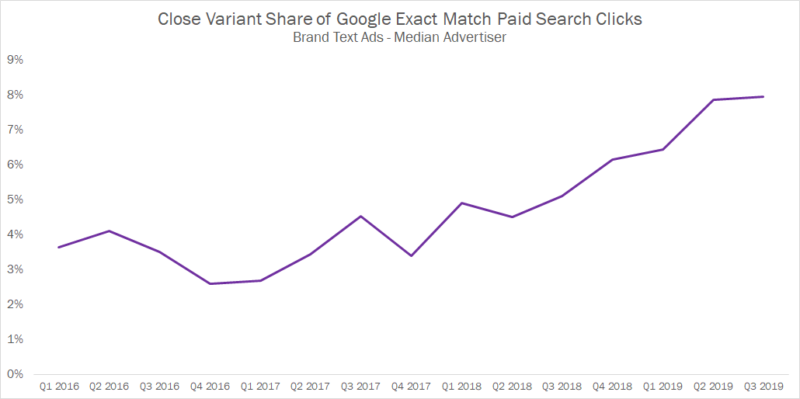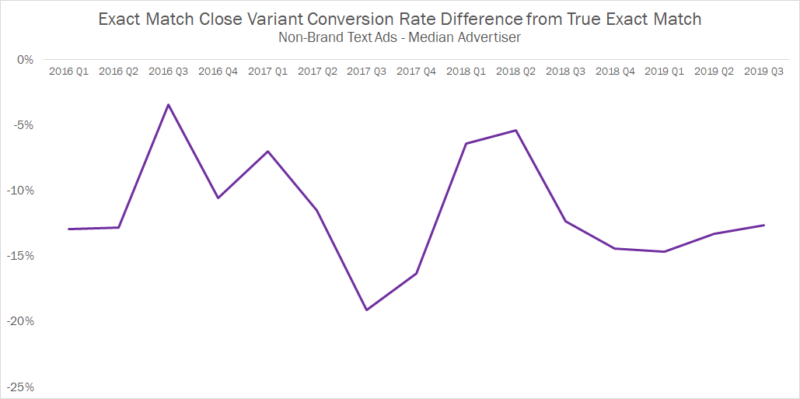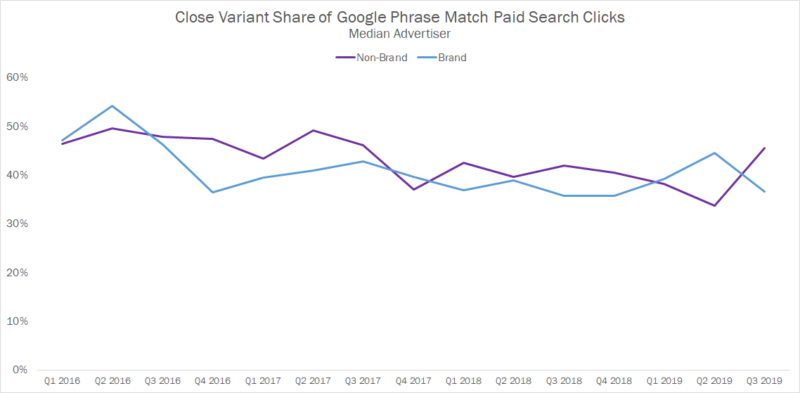Search query reports show a huge increase in Google close variant traffic
Here's a look at research based on the past year and how advertisers should think about close variants moving forward.
Google made its most sweeping change to the definition of close variants ever late last year when it announced that queries would now be considered exact match close variants if they were deemed by Google to have the same meaning as the keyword being bid on. While limitations in the past put hard constraints on the types of words that could constitute close variants, this change made it so that a query with any manner of relationship to the keyword could match in this way, so long as Google’s ad serving technology deemed it to have the same meaning.
As such, many marketers were rightfully concerned about potential harmful effects that this could have on performance. Here we dive into how close variant traffic has trended since the update was fully rolled out to English keywords last October, and how advertisers should think about it moving forward with a fresh close variant update now taking hold.
Close variants skyrocketed for both brand and non-brand keywords
Looking at the median share of exact match non-brand traffic coming from close variants in Google search query reports for a sample of long-standing Tinuiti (my employer) advertisers, close variant share clearly took off in Q4 of last year and has remained elevated ever since. Close variant click share went from 26% in Q3 2018 to 35% so far in Q3 2019.

This share is based on the match type assignment available in Google search query reports, which is populated based on the relationship of the query to the keyword triggered, rather than the match type a keyword is set to. As such, it gives a sense for how more traffic an advertiser with keywords set only to exact match might expect from close variants than if exact match were restricted to true exact matches.
The trend looks similar for brand keywords, where close variant share of exact match clicks went from 5% last Q3 to 8% this year.

The concern for marketers is that these close variants might not carry the same intent as true exact match queries, affecting their value and how much advertisers are willing to spend for the traffic. Looking at the relative conversion rate of close variants, such concern isn’t without merit.
Non-brand close variant conversion rate typically 10%-15% lower than true exact matches
For the median advertiser, close variant conversion rate is regularly at least 10% lower than that of true exact match for non-brand keywords. The additional close variant matches unleashed with the Google change last October do not appear to be meaningfully worse in terms of conversion rate relative to true exact match than previous close variant matches were, given relative conversion rate has been relatively steady since the update.
However, this comparison is heavily impacted by the efforts of our account managers, who are regularly weeding out any poor-performing queries through keyword negatives to reduce any negative effects of close variants on account performance. These efforts also slow the growth of close variant click share.

In Q3 2019, non-brand close variants are converting at a rate 13% lower than true exact matches for the median advertiser studied, but median non-brand close variant cost per click is 2% higher than that of true exact match. Naturally advertisers would like to bring the cost of close variant traffic in line with the relative value of that traffic, but Google’s changes have made it more difficult for advertisers to ensure the best possible bid is being placed for the queries now bundled into close variants.
Fortunately, brand close variant conversion rate is identical to true exact match conversion rate on average for the median advertiser over the last three years. This indicates that Google is usually very good at identifying close variants that do carry the same intent as brand searches.
However, that’s not the case for every advertiser. Brand close variants averaged a conversion rate 33% lower than that of true exact matches in the worst-case example of the advertisers studied, and some brand names are more susceptible to inappropriate matches through close variants.
Knowing this, someone might want to get Jason Fried to sit down before he checks Basecamp’s brand search query reports given the types of close variants I imagine might get pulled in to match for a term like ‘basecamp.’
Conclusion
Close variant performance can vary by advertiser, campaign, keyword and specific close variant match. While most advertisers see these matches convert at meaningfully lower rates than true exact matches for non-brand keywords, some actually see higher conversion rate from close variants looking at this comparison account-wide. However, there’s likely no account where close variants are so relevant and tightly related to all the keywords being triggered that advertisers should simply allow them to take their course.
As such, advertisers must continue to regularly evaluate search query reports to find close variants that should be weeded out via keyword negatives to minimize wasted spend from any inappropriate matches. Google reiterated as much in their most recent announcement that same-meaning close variants will now be applied to phrase match and broad match modifier keywords.
Taking a look at the share of phrase match traffic attributed to close variants, the share is already quite high compared to exact match, but had been trending lower over time.

It’s unclear to what extent the most recent change has been rolled out given Google’s stated timeline in its July announcement of “in the coming weeks,” but it’s likely we’ll see an uptick in phrase match close variant share in the quarter to come. I’ll certainly be keeping an eye on it as we head into the holiday season given how significant the increase in close variants was in the last Q4.
Opinions expressed in this article are those of the guest author and not necessarily Search Engine Land. Staff authors are listed here.
Related stories